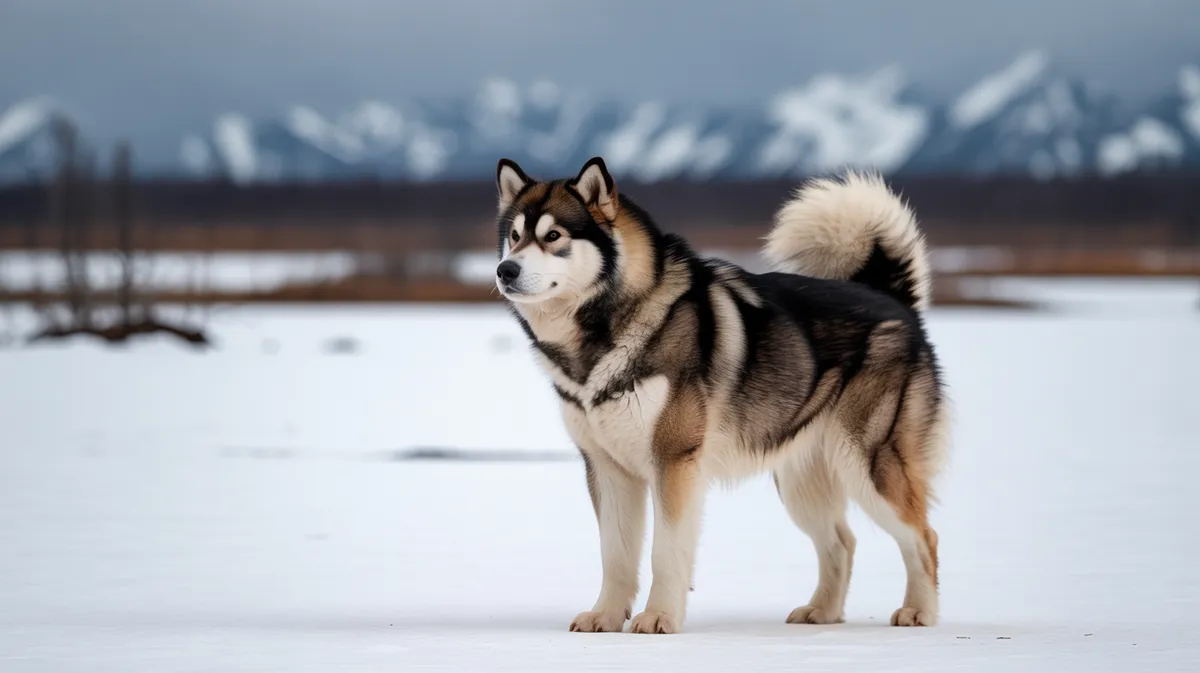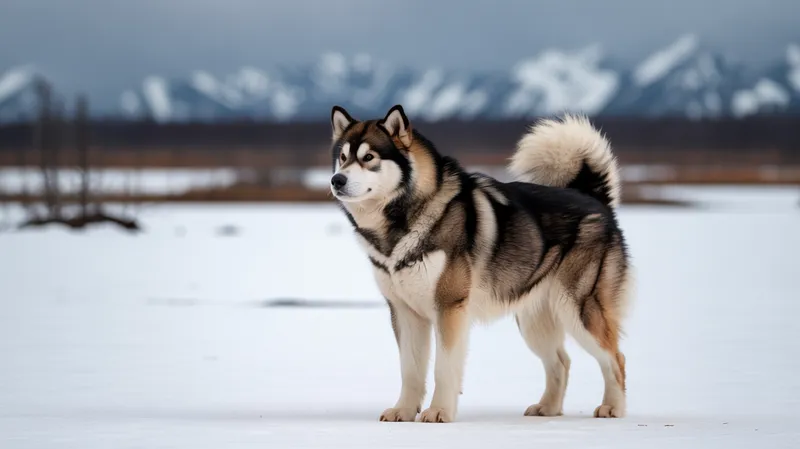
Alaskan Malamute
Canis lupus familiaris

Meet the Alaskan Malamute
The Alaskan Malamute is a large, powerful breed of domestic dog originally bred for its strength and endurance to haul heavy freight as a sled dog in the Arctic. With a thick double coat, erect ears, and distinctive facial markings, Malamutes are well-adapted to cold, harsh environments. They are known for their friendly disposition, intelligence, and loyalty, making them beloved companions as well as working dogs. While they resemble wolves in appearance, they are a distinct, domesticated breed with a gentle temperament. Their high energy and need for exercise make them best suited to active families and experienced owners.
Classification
Mammal
Habitat
Arctic and subarctic regions, domestic environments
Diet
Omnivore
Lifespan
10-14 years
Conservation
Least Concern
Weight
34–43 kg (75–95 lbs)
📖Fascinating Facts
Impressive Strength
Alaskan Malamutes are capable of pulling several times their own body weight, making them exceptional sled and freight dogs.
Cold-Weather Adaptation
Their dense, waterproof double coat insulates them against extreme Arctic temperatures.
Historic Heritage
The breed was named after the Mahlemut Inuit tribe, who first developed and relied on the dogs for survival in Alaska's harsh environment.
📋Detailed Description
The Alaskan Malamute is a robust, large-boned dog breed, with males typically weighing 38–43 kg (85–95 lbs) and standing about 63.5 cm (25 in) at the shoulder, while females are slightly smaller at 34–38 kg (75–85 lbs) and 58.5 cm (23 in) tall. Their dense double coat consists of a coarse, water-resistant outer layer and a thick, woolly undercoat up to 5 cm (2 in) deep, providing exceptional insulation against Arctic temperatures. The breed is characterized by a broad head, erect, triangular ears, and a plume-like tail carried over the back. Malamutes display powerful musculature and large, snowshoe-like feet, adaptations for pulling heavy loads across snow and ice. Socially, they are pack-oriented, displaying strong bonds with both humans and other dogs, and often exhibit a gentle, playful demeanor. Their intelligence and problem-solving abilities are well-documented, though they are known for an independent streak. Malamutes are highly energetic, requiring significant daily exercise and mental stimulation. Their vocalizations include a characteristic 'woo-woo' sound and howling, rather than barking. Lifespan averages 10–14 years, with common health concerns including hip dysplasia, inherited polyneuropathy, and hypothyroidism.
💡 Did you know?
The Alaskan Malamute is one of the oldest Arctic sled dog breeds, developed by the native Mahlemut people of Alaska thousands of years ago.
🔬Research & Sources
Wikipedia Summary
The Alaskan Malamute is a large breed of dog that was originally bred for its strength and endurance, to haul heavy freight as a sled dog. It is similar to other arctic breeds such as the husky, the spitz, the Greenland Dog, Canadian Eskimo Dog, the Siberian Husky, and the Samoyed.
Last Modified: 4/14/2025
🎭Behavior & Social Structure
Alaskan Malamutes are highly social and thrive in environments where they can interact regularly with humans and other dogs. They exhibit pronounced pack behavior, often seeking a clear social hierarchy. As working dogs, they have a strong prey drive and may chase small animals. Their feeding behavior is opportunistic, and they benefit from a diet rich in protein and fat, reflecting their historical role as sled dogs. Malamutes are known for their endurance and stamina, capable of traveling long distances at a steady pace. They are intelligent but can be stubborn, requiring consistent, positive reinforcement training. Daily routines should include vigorous exercise, such as running, hiking, or pulling sleds or carts, to prevent boredom and destructive behaviors. They are generally not aggressive but can be assertive with other dogs, especially of the same sex. Malamutes are also known for their expressive vocalizations and body language, using these to communicate with both humans and conspecifics.
👶Reproduction & Life Cycle
Alaskan Malamutes reach sexual maturity between 12 and 18 months. The breed typically exhibits one estrus cycle per year, in contrast to many other domestic dogs that may cycle twice. Mating usually occurs in late winter or early spring, aligning with traditional sledding seasons. Gestation lasts approximately 63 days. Litter sizes range from 4 to 10 puppies, with an average of 6. Both parents may show protective behaviors, but maternal care is primary, with the dam nursing and grooming the pups for the first 3–4 weeks. Puppies are weaned by 6–8 weeks and begin socialization with the pack and humans. Responsible breeders screen for hereditary conditions such as hip dysplasia and polyneuropathy to ensure healthy offspring.
🛡️Adaptations & Survival
The Alaskan Malamute's physical adaptations are specialized for Arctic survival and labor. Their thick double coat insulates against extreme cold and repels moisture. Large, well-furred feet distribute weight efficiently on snow, reducing sinking and providing traction. The breed's strong, muscular build and deep chest enable them to pull heavy loads over long distances. Their bushy tail can be curled over the nose during rest to conserve heat. Behavioral adaptations include high endurance, strong pack instincts for cooperative work, and an ability to regulate activity levels to conserve energy in harsh conditions. Their keen sense of smell and hearing aid in navigation and communication in low-visibility environments.
📚Research Sources
🎨Cultural Significance
The Alaskan Malamute holds significant cultural value as the official state dog of Alaska, symbolizing endurance, strength, and the spirit of the Arctic. Historically, they were integral to the survival of Inuit and Mahlemut peoples, used for transportation, hunting, and hauling supplies. Malamutes have featured in literature, film, and folklore as archetypes of loyalty and resilience. Their image is often associated with exploration and adventure, particularly during the Alaskan Gold Rush and polar expeditions. Today, they participate in sled dog sports, therapy work, and serve as ambassadors for Arctic heritage.
🔬Recent Research & Discoveries
Recent genetic studies have clarified the Alaskan Malamute's ancestry, revealing close relationships with other Arctic breeds but distinct lineage from the Siberian Husky and wolf populations. Ongoing research focuses on inherited diseases such as Alaskan Malamute polyneuropathy (AMPN), with advances in genetic screening improving breed health. Studies on working dog physiology have highlighted the breed's remarkable aerobic capacity and thermoregulation. Behavioral research underscores the importance of early socialization and structured training to mitigate dominance-related issues. Conservation genetics is being applied to maintain genetic diversity within the breed.
🎥Wildlife Videos

Wildlife - Just Wild Dogs | Free Documentary Nature
Wildlife - Episode 7: Just Wild Dogs | Wildlife Documentary Watch 'Wildlife - Episode 8' here: https://youtu.be/kglJpB4ei8o Run ...
Free Documentary - Nature

HARSH ALASKA | The Survival Struggle of Wildlife | Animal documentary
Welcome to "HARSH ALASKA | The Survival Struggle of Wildlife," an awe-inspiring documentary that transports you to the rugged ...
WILD NATURE - Nature animal documentary

Alaska - The Last Frontier | Free Documentary Nature
Alaska - The Last Frontier | Nature Documentary Watch '8000 Miles to Alaska: A Journey Along the Longest Border in the World' ...
Free Documentary - Nature

The Incredible Life Of A Sled Dog (Wildlife Documentary) | Natural Kingdom | Real Wild
This is the story of an icon, the Canadian Inuit Dog; from ancient roots in the Arctic as the working sled dog of the Inuit to its ...
Real Wild

The Siberian Husky And Alaskan Malamute
The Siberian Husky is a medium size working dog breed that originated in north-eastern Siberia, Russia.The breed belongs to the ...
Best Documentary

WILD YELLOWSTONE | Ruthless Predators and Majestic Wilderness | Nature animal documentary
WILD YELLOWSTONE | Ruthless Predators and Majestic Wilderness | Nature animal documentary ...
WILD NATURE - Nature animal documentary
🌍Habitat Information
The Alaskan Malamute typically inhabits Arctic and subarctic regions, domestic environments environments. Alaskan Malamutes have adapted to their environments with specialized features and behaviors.
Primary Habitat:
Arctic and subarctic regions, domestic environments
More detailed habitat information will be available soon.
🛡️Conservation Status
The Alaskan Malamute is currently classified as Least Concern. Conservation efforts are crucial for preserving this species for future generations.
Common Threats:
- 🏠Habitat loss and fragmentation
- 🌡️Climate change impacts
- 🎯Hunting and poaching
- 🏭Human-wildlife conflict
⚠️Threats & Conservation Challenges
As a domestic breed, Alaskan Malamutes are not threatened in the wild, but face challenges such as irresponsible breeding, abandonment, and health problems related to genetic disorders. Their high energy and need for exercise can lead to behavioral issues if not met, resulting in relinquishment to shelters. Climate change and the decline of traditional sled dog roles in the Arctic have reduced working opportunities, though recreational mushing and companion roles persist. Overbreeding and lack of genetic diversity can increase the prevalence of inherited diseases. Malamutes are not considered at risk in terms of population, but breed-specific rescues are sometimes needed for displaced individuals.
🔬Scientific Classification
Scientific Name
Canis lupus familiaris
Classification Hierarchy
🔍 About Taxonomic Classification
Taxonomic classification is a hierarchical system used by scientists to classify and organize living organisms based on shared characteristics and evolutionary relationships.
The system moves from broad categories (Kingdom) to increasingly specific ones, with each animal's scientific name typically consisting of its Genus and species.
📝Community Notes
Share your observations and insights about the Alaskan Malamute with our community of wildlife enthusiasts.
Join Our Community
Sign in to share your observations and connect with fellow wildlife enthusiasts.
Sign In to ContributeNo community notes yet
Be the first to share your observations about the Alaskan Malamute!
Explore Alaskan Malamute
Select a tab above to learn more about this amazing animal.
📸Photo Gallery
No photos available for this animal yet.
🌟Discover More Wildlife
Continue your journey of discovery with more fascinating animals from our database
